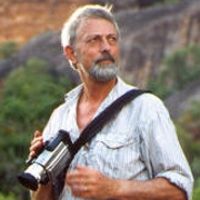Wallace Thornhill
Wallace Thornhill(1942 to present) or Wal as he is known, graduated in Physics at Melbourne University in 1964 and beganpostgraduate studieswith Prof. Victor Hopper’s upper atmosphere research group. Before entering university, he had been inspired byImmanuel Velikovskythrough his controversial best-selling book, Worlds in Collision. Wal experienced first-hand the indifference and sometimes hostility toward a radical challenge to mainstream science. He realized there is no career for a heretic in academia.
Wal worked for 11 years with IBM Australia. The later years were spent in the prestigious IBM Systems Development Institute in Canberra, working on the firstcomputergraphics system in Australia. He was the technical support for the computing facilities in the Research Schools at the Australian National University, which gave him excellent access to libraries and scientists there.

Wal最初是深受当时的revolutionary ideas of Immanuel Velikovsky of Princeton. Velikovsky proposed that mankind had been devastated in the past by cosmological events . Wal took these ideas and with his deep knowledge of astronomy and, plasma physics began his own questioning of scientific dogma. Paramount was the place of electro magnetism , as distinct from gravity ,in the formation of the universe . This slowly but surely led to his and other colleagues (such as David Talbot ,Donald Scott and Anthony Peratt ) questioning such ingrained theories as the big bang, black holes and Einstein’s theory of relativity. This group in particular contend that many scientific “proofs “are theory laden or mathematically concocted . An insistence on empirical data from observations and experiments gives their work true integrity.
For instance by observing images and measurements generated by NASA on planets, galaxies and stars we can see what is happening on Earth and our own solar system . In addition practical work on Plasma physics in the laboratory can replicate electrical machining seen on a geological scale both on Earth and on other planets . The electromagnetic effects from volcanoes ,earthquakes , and comets to mass coronal ejections appear better empirical explanations than reliance on theories perpetuated by say Hutton and Lyle with their reliance on uniformitarianism.
由于越来越多的教条的审查实施d by scientific journals over the last century, Wal, like many other independent researchers, has had to turn to minor journals for publication. He has written many papers for the U.S. journal, Aeon, and the Review of the Society for Interdisciplinary Studies (SIS), in England. He served as a council member of SIS for several years while working in London for the Australian government. He also attended a postgraduate course in Astrophysics at the University of London and meetings of the Royal Astronomical Society and the British Astronomical Association.
In recent years, Wal has achieved a broad synthesis of ideas that he calls “THE ELECTRIC UNIVERSE.” He believes that popular astronomy gives a distorted view of the universe. The modern vision evokes a sense of lonely bodies in space—isolated galaxies, self-immolating stars drifting like dust moats in the blackness, and the clockwork solitude of planets. In challenging this idea, he emphasizes connectivity. The electric force, he contends, influences matter at all levels, from subatomic particles to galactic clusters, leaving little room for the disconnected fragments of modern theory. It was first presented as such at a World Conference in Portland, Oregon, in January 1997, and provoked great interest from some professional astronomers, engineers and scholars in the humanities. A booklet and CD with that title were produced. Workshops and conferences were subsequently held in Portland, Oregon, and Seattle, Washington.
In 2000, Wal was one of the keynote speakers at a conference in Portland, along with the noted astronomer, Halton Arp, from the Max Planck Institute for Physics and Astrophysics in Germany, and the plasma cosmologist, Anthony Peratt, from the Los Alamos Laboratories, author of Physics of the Plasma Universe. Later that same year he shared the podium with Halton Arp at University College, London. [Arp has been dubbed the modern Galileo. He has done the definitive observational study to demonstrate that the Big Bang is fictional and has published many ideas that coincide with theElectric Universemodel.]
In 2001, Wal was a keynote speaker at the “Intersect 2001” conference in Laughlin, Nevada. The broad scope of the ELECTRIC UNIVERSE may be gauged by the connections established at that conference with the well-known Oxford biologist, Rupert Sheldrake, author of many books including Seven Experiments That Could Change the World; the cellular biologist, Bruce Lipton, and the psychologist, Garry Schwartz, of the University of Arizona. Anthony Peratt provided experimental evidence at that meeting, confirming that the powerful electric force is paramount in the universe.
Wal has published several books with David Talbot (author of The Saturn Myth)—the first titled Thunderbolts of the Gods and the second, The Electric Universe, on the combined subjects of the recent history of the solar system and the Electric Universe. More volumes are planned. Thunderbolts of the Gods was published this year in Japanese.
Meanwhile e-books are being made available on the Internet, The Big Bang?, The Electric Sun and The Comet being the first. Wal’s first peer-reviewed paper on the electrical nature of stars and supernovae was published in the IEEE Transactions on Plasma Science, Vol 35 No. 4, Special Issue on Space & Cosmic Plasmas – August 2007. A co-authored paper on the Martian “blueberry” phenomenon has been published and a co-authored paper in Japan on the plasma phenomenon at the centres of galaxies has been submitted for publication. Wal has been awarded a gold medal for 2010 by the European Telesio-Galilei Academy of Science.
Wal has a websiteHoloscience.com. It summarises the Electric Universe Model and provides up to date alternative views on scientific news.
Continue reading here:Cuvier and Schaeffer's Catastrophism!
Was this article helpful?